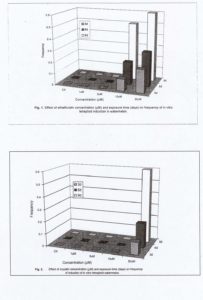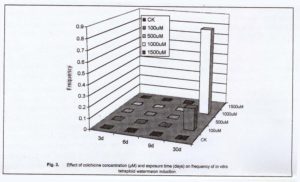Cucurbit Genetics Cooperative Report 22:38-40 (article 14) 1999
Ying Li
School of Plant, Statistical and Ecological Sciences, 111 Poole Agricultural Center, Clemson University, Clemson, SC 29634
John F. Whitesides
School of Animal and Veterinary Sciences, C123 Poole Agricultural Center, Clemson University, Clemson, SC 29634
Bill Rhodes
School of Plant, Statistical and Ecological Sciences, 111 Poole Agricultural Center, Clemson University, Clemson, SC 29634
Introduction
Autotetraploid lines are the maternal parents of triploid watermelon hybrids. Chromosome doubling was first accomplished with the toxic alkaloid colchicine by applying colchicine in lanolin paste to the growing point. More satisfactory tissue culture treatments have since been developed (4). Dinitroanilines have been used to double chromosome numbers, and their effectiveness has previously been compare with other crops (1,3,5). The purpose of these trials was to compare in vitro chromosome doubling effectiveness using colchicine and the dinitroanilines, ethalfluralin (N-ethyl-N-2 methyl-2-propenyl)-2, 6-dinitro-4-(trifluomethyl) benzanine), and oryzalin (3,5-dinitro-N4, N4dipropylsulfanilamide).
Methods
Single buds isolated from clones of an F3 seed were treated with colchicine (100, 500, 1000, 1500 μM) or dinitroanaline (5, 10, 50, 100 μM) in baby food jars with liquid MS medium plus 3% darkness on a platform shaker at 100 rpm for 3, 6, or 9 days. The treated buds were placed on MS medium plus 3% sucrose in 0.7% agar with 10 μM BA. The shoots were subcultured every 30-40 days.
Nuclear isolation procedures are described by Li et al. (2).Factoral experiments were conducted on the single buds in baby food jars with filter sterilized liquid MS medium in the dark. Ten single buds of approximately the same size were randomly assigned to each of the treatments . Thus, the experimental design was a completely random design, with no blocking. The treatment structure was a two-way factorial design. One factor was concentration and the other was exposure time. concentrations for dinitroanalines were 0, 1, 5, 10, and 50 μM, and exposure times were 3, 6, and 9 days. For colchicine, the concentrations were 0, 100, 500, 1000 and 1500 μM,and the exposure times were 3, 6, 9, and 30 days. Zero concentration also served as a control for the chemical agent.
Experimental unit and observational unit were the same: one single bud and the clone derived from it. response factor was ploidy level of each clone, which was classified as a tetraploid or non-tetraploid by DNA contents measured with flow cytometry.
For each oryzalin or ethalfluralin treatment,, in a 5×3 grid there were 15 different media with all possible combinations of concentrations and days. For colchicine, 20 different media were prepared. Some loss (variable, but usually less than 10%) resulted from contamination. Whole excised single buds from a single clone were placed on a liquid medium with one of the factorial combinations of concentrations and days.
The data from each of the factoral designs for tetraploid generations were analyzed for each chemical agent. Data recorded included the number of explants and their derived clones. statistical analysis was conducted using the GLM procedure of the statistical analysis system (SAS Institute Inc., Cary, NC, 1996). Percentage data were analyzed using the FREQ procedure, and CAT-MOD procedure (SAS), and the data sets that contained a large number of zeros were transformed using the square root transformation[(y + 0.5 1/2) before GLM or CATMOD analysis, or just processed by Fisher’s Exact Test. An analysis of variance was also conducted on the data by CATMOD procedure, GLM procedure, and Fisher’s Exact Test (SAS). Paired comparisons were made using the three methods listed to compare the relative efficiency of tetraploid induction among these three chemicals (SAS)P, and to determine interaction and the main effects of concentrations and days for each chemical agent, respectively. All calculations were performed on contingency of ploidy level on the two factors (concentration and days). Specific hypotheses involving effect of different chromosome-doubling agent, concentration, and different time period on ploidy were tested using subsets of the overall contingency data (SAS).
Results
All of the treated buds survived the chromosome doubling treatments, but some browning was observed on the edges of the tiny leaves. No higher treatment levels of the dinitroanalines were attempted.
In contrast to oryzalin, ethalfluralin at 10 μM induced 50% tetraploids in 9 days, statistically as many as either dinitroaniline at the higher concentration of 50 μM (Fig. 1 and 2). concentrations of ethalfluralin between 10-50 μM should be tested. Because the dinitroanilines cost the same, ethalfluralin may be preferred over oryzalin.
Using colchicine, 30 days exposure time was more effective than 3, 6, or 9 days in inducing tetraploids (Fig. 3). At 30 days exposure, 1000 μM concentration was more effective than 100 μM in tetraploid induction. Because colchicine induces tetraploidy more slowly than these two dinitroanilines and is also more toxic and more expensive, the dinitroanilines are attractive candidate alternatives to colchicine for chromosome doubling in watermelon.
Literature Cited
- Hansen, N.J.P., and S.B. Andersen. 1996. In vitro chromosome doubling potential of colchicine, oryzalin, trifluralin, and APM in Brassica napus microspore culture. Euphytica 88:159-164.
- Li, Ying, John F. Whitesides and Bill Rhodes. 1999. Preparation of nuclei from in vitro watermelon shoot tissue for cell flow cytometry. Cucurbit Genetics Coop. Rpt. 22:43-46.
- Tosca, A., R. Pandolfi, S. Citterio, A. Fasoli, and S. Sgorbati. 1995. Determination by flow cytometry of the chromosome doubling capacity of colchicine and oryzalin in gynogenetic haploids of Gerbera. Plant Cell Reports 14:455-458.
- Zhang,m X.P., B.B. Rhodes, and J.W. Adelberg., 1994. Shoot regeneration from immature cotyledon of watermelon. Cucurbit Genetics Coop. Rpt. 17:111-115.
- Zhao, J. and D.H. Simmonds. 1995. Application of trifuralin to embryogenic microspore cultures to generate doubled haploid plants in Brassica napus. Physiologia Plantarum 95:304-309.

